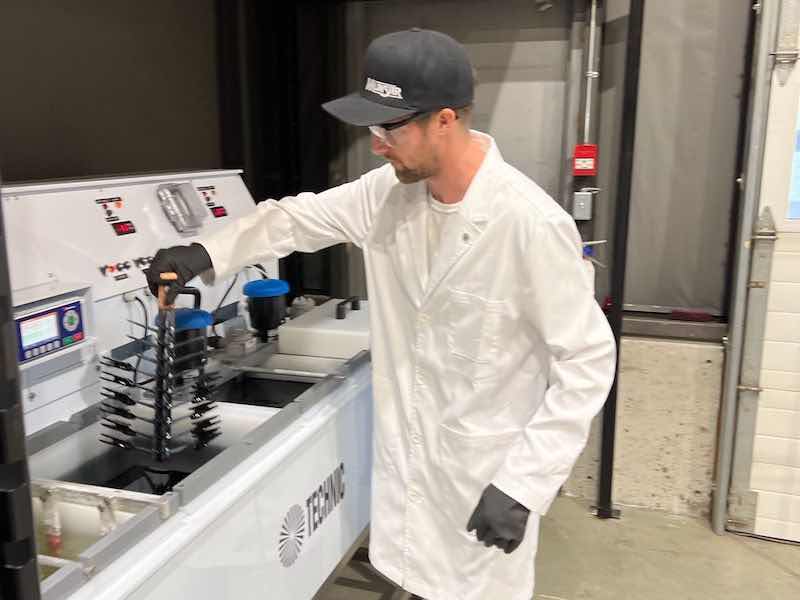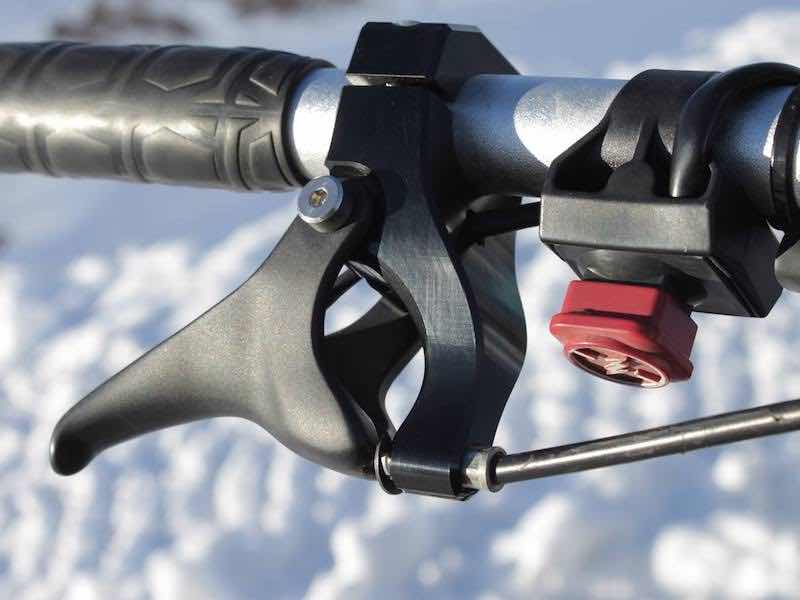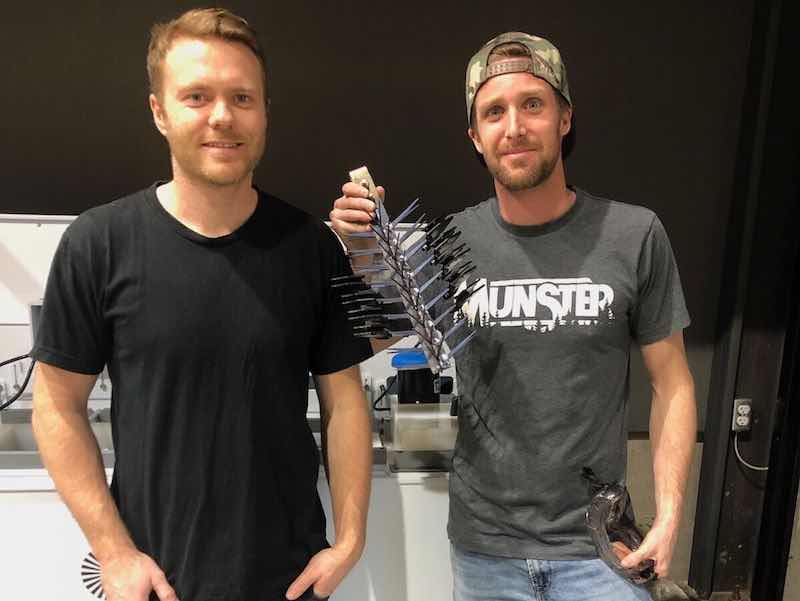For Andrew Munster, sledding down a snow-covered mountain at breakneck speed while dodging trees and rocks isn’t that big of a worry for the Canadian snowmobile legend.
But when it comes to the finishes of the after-market parts his company makes and sells to other devoted sledders, that is an entirely different story.
This is why his company — appropriately named Munster Canada — was concerned with sending its finger throttles, kill switches, bushing savers, rail braces, and brake levers nearly three hours away to be anodized and returned.
Improving Quality and Turn-Around
 Technic’s LAMP is a modular system that has two compartmentalized stations that provide a full anodizing process.“Quality, consistency, and turn-around time was all becoming an issue,” says Jake Quinn, Munster’s business partner. “It was really starting to hamper our own production schedule.”
Technic’s LAMP is a modular system that has two compartmentalized stations that provide a full anodizing process.“Quality, consistency, and turn-around time was all becoming an issue,” says Jake Quinn, Munster’s business partner. “It was really starting to hamper our own production schedule.”
That sent Munster and Quinn on a quest to see if they could have an in-house anodizing process without breaking their budget. They had done it three years earlier when they decided to bring all machining operations into their Squamish, British Columbia, headquarters just north of Vancouver.
They looked at very small home anodizing kits — which they quickly ruled out — and explored some lines that would cost several hundred thousand dollars.
“There really wasn’t much in between to do the batch work that we needed to get done,” Quinn says.
That’s when Munster and Quinn came across Technic, the Rhode Island-based company that just celebrated its 75th year supplying specialty chemicals, custom finishing equipment, engineered powders, and analytical control systems to the semiconductor, electronic component, printed circuit board, industrial finishing, and decorative industries.
Technic’s Laboratory Anodizing Mini-Plant
 Munster Canada makes finger throttles, kill switches, bushing savers, rail braces, and brake levers.For decades, Technic has manufactured and sold small-scale production plating lines for research, application testing, and new product development but has not offered an anodizing line that fits the same mold.
Munster Canada makes finger throttles, kill switches, bushing savers, rail braces, and brake levers.For decades, Technic has manufactured and sold small-scale production plating lines for research, application testing, and new product development but has not offered an anodizing line that fits the same mold.
But in early 2021, Technic brought on Christian Ebbrecht to serve as the company’s new market manager for Technic’s anodizing equipment line, and one of the first things Ebbrecht decided was to offer a small-scale production system for the anodizing industry.
Previously, the Technic “Mini Plating Plants” provided small-scale countertop production in a variety of processing options for rack, basket, vibratory, and barrel processing. It didn’t take long with Ebbrecht’s push to get Technic — which already sold full-scale larger anodizing systems for job shops and factories — to scale down the technology and launch a Laboratory Anodizing Mini-Plant product line, or LAMP for short.
“It is essentially the exact same concept of what Technic has been offering on the plating side,” Ebbrecht says. “We’ve been perfecting these for almost 30 years, so it was just adjusting the size of the tanks a little bit and increasing the number of stations.”
Technic’s LAMP is a modular system that has two compartmentalized stations that provide a full anodizing process. Ebbrecht says one pre-finish module is used for cleaning and surface modification, and the second module has an anodizing station and post-treatment for dye and seal. An optional 50-gallon Moonstone wastewater treatment system by Kontek Water Systems is available.
Designed for Machine Shops and Smaller OEMs
 Andrew Munster competes in snowmobile events in Canada and across the world.Ebbrecht says this entry-level system is essentially designed for machine shops and OEMs interested in having an internal unit with R&D capabilities. He says specific anodizing processes may be developed and optimized through application testing.
Andrew Munster competes in snowmobile events in Canada and across the world.Ebbrecht says this entry-level system is essentially designed for machine shops and OEMs interested in having an internal unit with R&D capabilities. He says specific anodizing processes may be developed and optimized through application testing.
“We had a lot of interest from some small manufacturers who are growing to the point where they wanted to manage their own finishing experience,” Ebbrecht says. “Some plating and anodizing lines can get up to half a million dollars, but this system is for those smaller facilities that want to control the quality, as well as the lead times.”
The LAMP footprint is around 72 inches long, 26 inches wide, and 28 inches tall. The part window size is 10 inches by 12 inches.
The first module is for pretreatment and includes four poly tanks (15 x 15 x 15) and two heaters. The tank sets are alkaline cleaner, etch, rinse, and deox. The second module is for anodizing, and post-treatment is also four tanks of the same size for anodizing, rinse, dye, and sealing.
An included rectifier is a continuous-duty 50 amp, 45 volts with a programmable controller, and an air-cooled chiller with a pump installed to maintain anodize tank bath set points between 55 ̊-70 ̊F. Ventilation boxes are integrated into the console and ready for an exhaust connection.
“A facility can put parts in the tanks every 30 minutes and have a really good production line going,” Ebbrecht says.
Booming Snowmobile After-Market Part Business
 And that is just what the Munster team is doing with parts for their company, which boomed as the owner’s popularity grew among sledders in Canada and elsewhere around the globe.
And that is just what the Munster team is doing with parts for their company, which boomed as the owner’s popularity grew among sledders in Canada and elsewhere around the globe.
Now in his late 30s, Munster took a love of engineering, his business degree, and his fame as a sledder to start designing his own parts for those who enjoyed the thrill of barreling down steep, show-covered mountains as high speeds.
His first product — a reconfigured finger throttle that he preferred over flipping around the stock flapper normally used by the thumb — took off among enthusiasts, which led to more parts being designed by Munster.
His products now include a Kill Switch — which doesn’t necessarily stop the engine each time something hits it, such as a sledder’s body leaning into it — the Reverse Switch, Ski Bushing Savers, Ski Bushing Stiffeners, Rail Braces, an Arctic Cat Brake Lever, the Throttle Guard, and the Munster Bar Riser.
“I see my company continuing to grow, not larger, but instead aiming to a high level of sustainability, where I can continue to invest my time and money into new ideas that raise the level of innovation in the industry,” Munster told Mountain Sledder.
The Goal of Making, Coating Quality Parts
He says the goal with his company — and the new anodizing line and CNC machines he has added over the years — is fairly simple: make quality parts.
“That means taking the time to engineer and test a part that meets 100% of the expectations set,” Munster says. “My friends often tease me because I tend to get an idea and obsess over it. The idea grows and grows until it becomes something I believe in and, in turn, have to achieve. That process is the basis of many of my products.”
Quinn says the Munster team quickly learned about the anodizing process while they were awaiting the system to be delivered this year and that Ebbrecht flew in to help them set up the line and to train them on it.
“We went into this fairly blind,” Quinn says. “But Christian helped us get this up and running and put us in contact with the right chemistry suppliers and the correct lab equipment, and it has gone really smoothly for us.”
The Munster team can put about 60 parts on one anodizing rack, which Quinn says is about one day’s worth of production from a CNC machine. On days when they do run parts, they can usually run 10 racks each day.
“We really couldn’t be happier with how the system has worked for us,” he says. “More than anything, we now have control over this process, and we’ve learned quickly that is one of the most important aspects in the manufacturing process.”



































